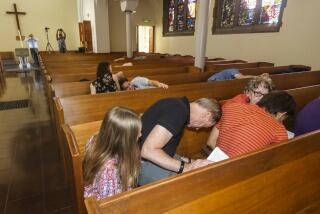No deaths reported in major Italian quake, but a 14th century basilica was among many buildings destroyed
- Share via
Reporting from SIENA, Italy — A magnitude 6.6 earthquake struck central Italy on Sunday morning, destroying a 14th century basilica built on the birthplace of St. Benedict and bringing down scores of buildings, days after two other shocks left thousands homeless.
About 20 people were injured, none fatally, when the quake struck at 7:40 a.m. three miles from the ancient town of Norcia in the Umbria region, Italian Prime Minister Matteo Renzi said.
Lives were probably saved because 1,300 people in the region had been moved to makeshift accommodations after their homes were damaged by two temblors Wednesday in the Umbria and Marche regions.
Sunday’s quake was the strongest in seismically active Italy in 36 years, since a quake near Naples killed 3,000 in 1980. The Sunday temblor was linked by experts to a 6.1 quake on Aug. 24, which killed 298 and leveled the towns of Amatrice and Accumoli in the nearby region of Lazio.
It all came down. Now there is no more town
— Aleandro Petrucci, mayor of Arquata del Tronto
“From the 10,000 people now needing assistance, we risk arriving at 100,000,” said Luca Ceriscioli, governor of the Marche region, on Italy’s Adriatic coast, after Sunday’s quake.
In Norcia, monks prayed amid ruins, and weeping nuns were escorted to safety by firefighters after the collapse of thebasilica of St. Benedict — the founder of the Benedictine order of monks — leaving only its facade standing.
“People are trapped in the main square, as nearby buildings may collapse. Trucks are coming to clear a path to safety,” the monks tweeted.

Felt as far away as Slovenia and Croatia, the quake brought down buildings in Italian towns partly evacuated after Wednesday’s temblors.
“Everything’s collapsed. I see plumes of smoke. It’s a disaster,” said Marco Rinaldi, mayor of Ussita, a town in the Marche damaged during the week.
“I was sleeping in the car, and I saw hell,” he told Italy’s ANSA news agency.
In Castelsantangelo sul Nera, another town damaged Wednesday, more buildings collapsed and huge cracks appeared in nearby mountainsides.
“At the cemetery, the shocks have split open tombs and the coffins have been thrown out. It’s indescribable and people cannot take it anymore,” Mayor Mauro Falcucci said.
About 60% of the buildings in Castelluccio, a picture-postcard village near Norcia that is popular with hikers, reportedly collapsed in Sunday’s quake.
Towns damaged by the Aug. 24 quake were also hit again, including Arquata del Tronto in the Marche.
“It all came down. Now there is no more town,” said Mayor Aleandro Petrucci. “The few people who remained have gone out to the streets and are embracing.”
In L’Aquila, where an earthquake in 2009 killed 300, a building yet to be repaired collapsed Sunday.
Although the U.S. Geological Survey measured Sunday’s quake at 6.6, Italy’s Institute of Geophysics and Volcanology put it at 6.5.
The shock was felt strongly in the Italian capital, Rome, where residents poured onto the streets in panic as beds shook and items tumbled from shelves.
One of the city’s historic basilicas, St Paul’s Outside the Walls, suffered cracks in its facade, and the city’s subway was shut for structural checks.
At his Sunday Angelus prayer in St. Peter’s Square, Pope Francis said, “I’m praying for the injured and the families who have suffered the most damage, as well as for rescue and first-aid workers.” Throughout the region, priests were advised to hold their Sunday Masses outdoors.
“We will rebuild everything, the houses, the churches and the businesses,” Renzi said. “Everything that needs to be done to rebuild these areas will be done.”
After this year’s series of devastating quakes along central Italy’s mountainous spine, the deputy mayor of Norcia, Pierluigi Altavilla, said he was less optimistic, telling Rai News 24, “We are starting to despair. There are too many quakes now; we can’t bear it anymore.”
Kington is a special correspondent.
ALSO
Gabriele Amorth, Roman Catholic priest known as the Vatican’s exorcist, dies at 91
Tension between U.S. and Russia brings war worries for some Muscovites
More to Read
Sign up for Essential California
The most important California stories and recommendations in your inbox every morning.
You may occasionally receive promotional content from the Los Angeles Times.









